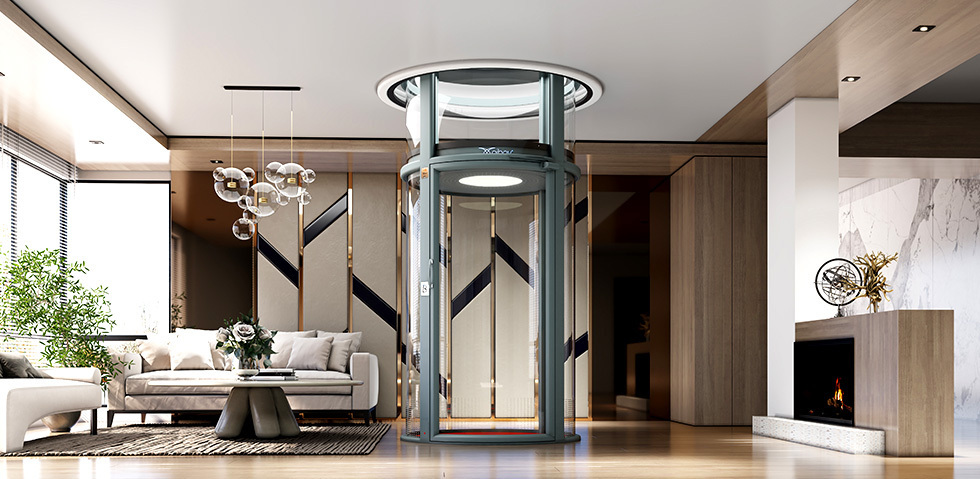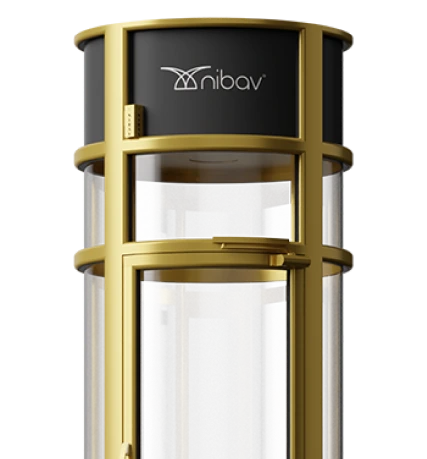Are you considering upgrading your multi-level home with a home elevator? While they may seem like a luxury addition, elevators can be a surprisingly cost-effective alternative to moving to a single-story home. When you factor in the expenses of moving, adjusting to a new environment, and potentially downsizing your belongings, an elevator can be a practical investment. Home elevators offer a secure and comfortable solution for navigating your home’s different floors, promoting continued independence and ease of movement throughout your living space.
What Types of Home Elevators Are Available in the UAE?
In this guide, we’ll explore the different types of home elevators available in the UAE, including their functionalities and price points. Whether you’re seeking a sleek, modern design or a space-saving option, we’ll help you find the perfect fit for your needs and budget. Our goal is to ensure that you’re well-informed about the various options available, from traditional hydraulic elevators to innovative pneumatic systems.
How Much Does Installing a Home Elevator Cost?
The cost of installing a home elevator in the UAE typically ranges from approximately AED 94,505 to AED 1,27,305, depending on factors such as the number of floors served, elevator cab configuration, design preferences, and other considerations. Our price quotes cover tax, shipping, and installation fees, providing clarity for your budget planning. However, additional costs such as permits, architectural services, or home renovations may apply, especially for constructing the elevator shaft. It’s important to note that while some dealers may advertise lower prices, these figures might not include all necessary expenses.
What Factors Influence the Cost of a Home Elevator?
- Type of Elevator: Hydraulic, traction, or pneumatic elevators each have different price points based on their technology and features.
- Number of Floors: The more floors served, the higher the cost.
- Customization and Design: Tailoring the elevator to your home’s aesthetic can increase costs.
- Installation and Maintenance: These costs include excavation work, electricity, and licensing fees.
How Can I Get an Accurate Cost Estimate for My Home Elevator?
For an accurate cost estimate tailored to your home’s specifications, feel free to reach out to us at +971 503 591 851 or request a free air-driven home elevator quote. We maintain strong relationships with numerous building contractors and architects to ensure a seamless and timely project execution. Our team is here to assist you every step of the way.
Will Installing a Home Elevator Increase My Property’s Value?
Not only do home elevators enhance accessibility and convenience, but they can also significantly increase your property’s value. By providing effortless floor-to-floor access, home elevators appeal to potential buyers seeking flexibility and luxury. Whether you’re considering a home elevator for current needs or future resale value, it’s clear that the advantages far outweigh the initial investment.

What are the Costs and Types of Home Elevators?
Are you considering installing a home elevator but unsure about the costs and types available? Here’s a comprehensive guide to help you make an informed decision.
What Types of Home Elevators Are There?
Home elevators come in various forms, each with its own set of features and price ranges. Let’s dive into the details:
1. Air-Driven Home Elevators: A Stylish Option
Cost Range: AED 94,505 to AED 1,27,305
These elevators, also known as vacuum elevators, use air pressure to move a cabin up and down a transparent tube. They are sleek, energy-efficient, and perfect for those who value aesthetics.
2. Traction Elevators: The Most Common Choice
Cost Range: AED 75,000 to AED 150,000
Traction elevators use steel ropes or belts and pulleys. They are versatile and widely used but can vary significantly in cost based on size and features.
3. Machine-Room-Less (MRL) Elevators: Space-Saving
Cost Range: AED 70,000 to AED 120,000
MRL elevators eliminate the need for a dedicated machine room, making them ideal for homes with limited space. Their cost depends on factors like capacity and travel distance.
4. Cable-Driven Elevators: Traditional and Reliable
Cost Range: AED 75,000 to AED 150,000
These elevators use steel cables and a counterweight. They are common but require regular maintenance to ensure smooth operation.
5. Shaftless Elevators: Compact and Convenient
Cost Range: AED 94505 to AED 99,999
Also known as through-the-floor elevators, they are perfect for small homes or spaces where a traditional elevator shaft isn’t feasible.
6. Hydraulic Elevators: Smooth and Quiet
Cost Range: AED 50,000 to AED 150,000
Hydraulic elevators use a piston and hydraulic fluid to move the car. They offer a smooth ride but may require more space for the machinery.
How to Choose the Right Home Elevator
When selecting a home elevator, consider factors such as budget, available space, and personal preferences. Here’s a quick comparison:
| Elevator Tyle | Cost Range |
| Air-Driven Home Elevators | AED 94,505 – AED 1,27,305 |
| Traction Elevators | AED 75,000 – AED 150,000 |
| Machine-Room-Less (MRL) Elevators | AED 70,000 – AED 120,000 |
| Cable-Driven Elevators | AED 75,000 – AED 150,000 |
| Shaftless Elevators | AED 94505 – AED 99,999 |
| Hydraulic Elevators | AED 50,000 – AED 150,000 |
How Can a Home Elevator Improve Your Daily Life and Property Value?
Installing a home elevator can profoundly impact your daily life by offering numerous advantages that enhance your living experience. Here are the key benefits of having a home elevator:
- Enhanced Mobility: For individuals with mobility issues, a home elevator provides easy vertical transportation, fostering independence and reducing the need for assistance from others.
- Increased Safety: An elevator serves as a safe and stable alternative to stairs, minimizing the risk of falls and injuries. This ensures peace of mind for all family members.
- Improved Accessibility: With level entry into each floor, individuals with mobility limitations can access all areas of their home without using stairs, facilitating aging in place.
- Higher Property Value: Adding an elevator can boost a home’s value by enhancing livability, appeal, and functionality, offering a strong return on investment.
- Luxurious Convenience: A home elevator adds a touch of luxury and prestige, providing effortless access between floors and enhancing daily living for all homeowners.
The cost of a home elevator varies based on factors such as size, capacity, number of floors served, and desired features. However, the long-term benefits and potential increase in property value make it a valuable investment for many homeowners.
What Are the Top Factors That Impact Home Elevator Costs?
While home elevators offer numerous benefits, they also represent a significant investment. The total cost is influenced by several key factors, which are outlined below:
Size and Weight Capacity: The physical dimensions and weight capacity of your home elevator impact the price. Standard models range from compact 2-3 person to spacious 4-5 person options. Larger cabs and higher weight capacities (up to 1500 lbs) require more robust systems, increasing costs.
Design and Materials: The design, finishes, and materials used affect aesthetics, durability, and cost. Premium materials like glass, aluminum, and stainless steel add expense. Customizable options for the cab interior, such as flooring and lighting, elevate sophistication but also the price.
Installation Requirements: The complexity of installation based on your home’s structure impacts pricing. Elevators may require structural reinforcements, new electrical systems, and building out a shaft. Minimal preparation work keeps labor costs lower.
Drive System and Travel Distance: The type of drive system (hydraulic, cable, or air-powered) and travel distance influence costs. Air-powered elevators are often more affordable due to easier installation. Longer distances require more powerful systems, impacting price.
Customization Extras: Personalized options allow for a unique elevator but add to the cost. Choices like wood panels, indirect lighting, and music systems enhance the experience but require an investment premium.
Specialty Design Elements: Unique designs, such as outdoor lifts or curved spaces, increase costs due to weatherproofing, safety engineering, and custom fabrication.
Safety and Accessibility Features: Add-ons like video monitoring, emergency systems, and ADA-compliant details are important but require extra hardware and electronics, increasing costs.
Speed and Drive System: Faster lift speeds demand more robust systems, escalating pricing. Typical residential elevators average 30-40 feet per minute, while high-speed models range from 60-150 fpm.
Location-Based Factors: Geographic location affects pricing due to shipping costs, local labor rates, permitting fees, and sales tax. Research location-specific expenses to elevate the total budget.
Maintenance Plans: Ongoing maintenance ensures optimal performance and lifespan. Plan for annual inspections, regular cleaning, component testing, and 24/7 repair service plans to factor in maintenance costs upfront.
Understanding these factors can help you estimate the total cost of a home elevator and make informed decisions about your investment.
Expert Insights into Home Elevator Installations
When considering a home elevator installation, it’s essential to understand the various configurations available and how they can enhance your living space. Here are some common installation types that cater to different needs and architectural styles:
1. Standard Installation: A Classic Approach
Typically, home elevators are installed in a downstairs room, such as a hallway or family room, and travel upwards to a bedroom or landing. This setup is straightforward and efficient, providing easy access between floors.
2. Stairwell Integration: Maximizing Space
Air-powered elevators are particularly well-suited for homes with limited space due to their compact design. They can be seamlessly integrated into the unused space of a staircase, offering an innovative solution for maximizing vertical space.
3. Closet-to-Closet Installation: Discreet Elegance
Glass elevators are designed to fit within closets across different floors, providing an elegant and practical solution for those seeking a discreet addition. This configuration is ideal for maintaining the aesthetic integrity of your home.
4. Full-Floor Access Installation: Unparalleled Convenience
This unique feature allows entrance from one side and exit from the opposite, offering unparalleled convenience and efficiency in navigating your home. It’s perfect for homes with open floor plans or those requiring easy access to mobility aids.
5. Sloped or Cathedral Ceiling Installation: Seamless Integration
Our elevators can be adapted for homes with sloped or cathedral ceilings, requiring minimal structural adjustments for installation. This ensures that your home’s aesthetic and structural integrity are preserved while enhancing accessibility.
6. Garage Installation: Secure and Efficient Entry
Installing a residential elevator in your garage provides a secure and direct route into your home. This setup involves constructing a simple enclosure and utilizing air-driven home lifts for smooth operation, making it an efficient and safe entry point.
Final Thoughts on Home Elevator Costs: Long-Term Benefits
While the initial cost of a home elevator may seem substantial, remember the long-term benefits of increased accessibility and potential home value appreciation. To ensure the best fit for your budget and needs, gather quotes from different installers and explore financing options. This investment not only enhances your daily living experience but also provides a valuable asset for your property.
FAQ’s
1. What is the average cost of installing a home elevator in 2025?
The average cost of a home elevator in 2025 starts at around AED 94,505 – AED 1,27,305, depending on factors like the type of elevator, number of floors, and customization options
2. What factors affect the cost of a home elevator?
Key factors include the type of elevator (e.g., pneumatic, hydraulic), number of floors, installation complexity, customization options, and whether it’s a new build or retrofit
3. How much does a pneumatic elevator cost?
Pneumatic elevators, known for their luxury and glass cabins, typically cost between AED 94,505 – AED 1,27,305
4. How long does it take to install a home elevator?
Installation times vary, but pneumatic elevators like those from Nibav can be installed in as little as 2-3 days due to their minimal construction requirements.
Ready to Take the Next Step? Contact our expert team at Nibal Lifts today to get a quote for an air-driven home elevator. Reach us at +971 503 591 851, email us at info@nibavlifts.ae, or submit an elevator inquiry form on our website. Don’t wait to improve your home’s accessibility and comfort!




